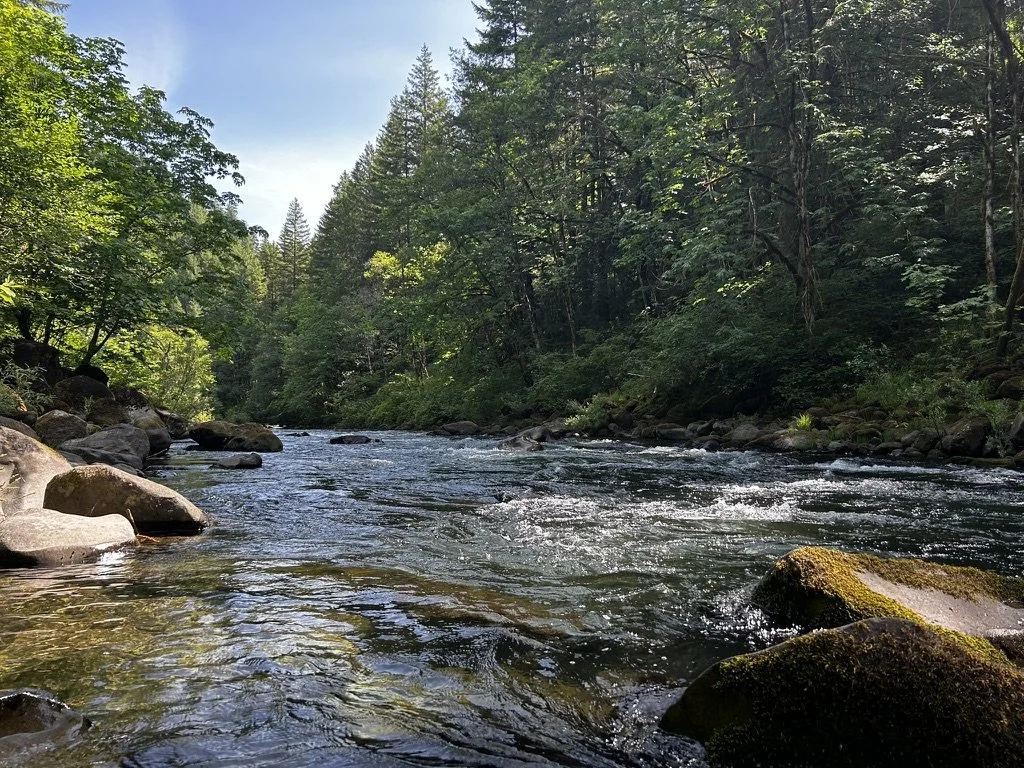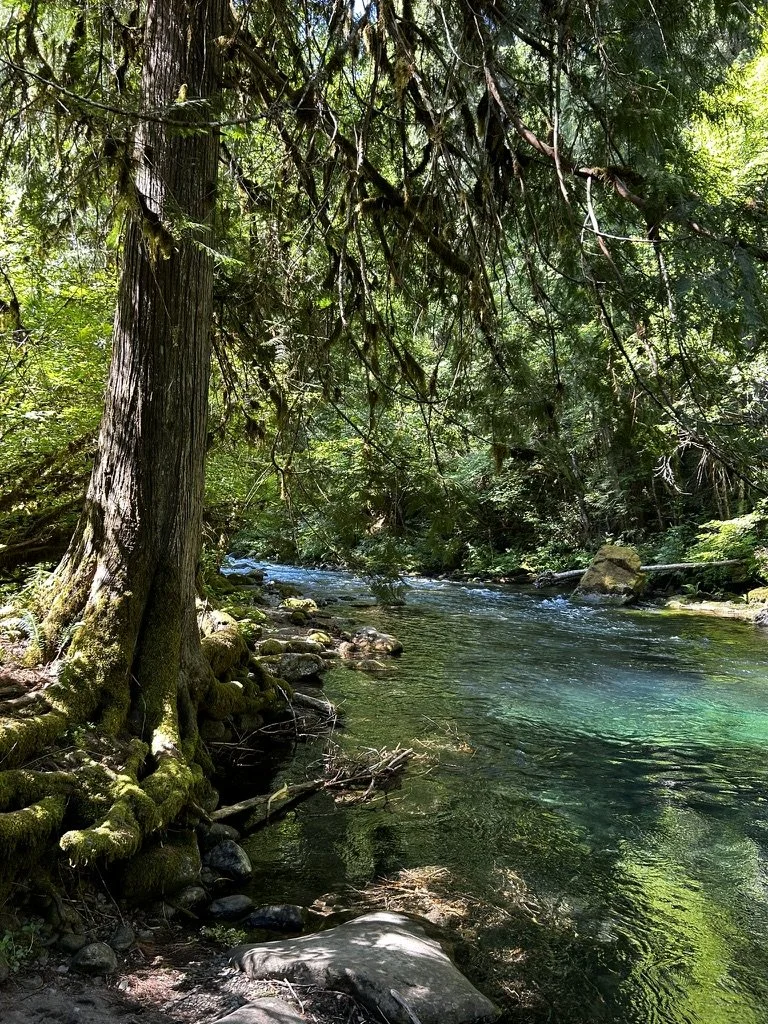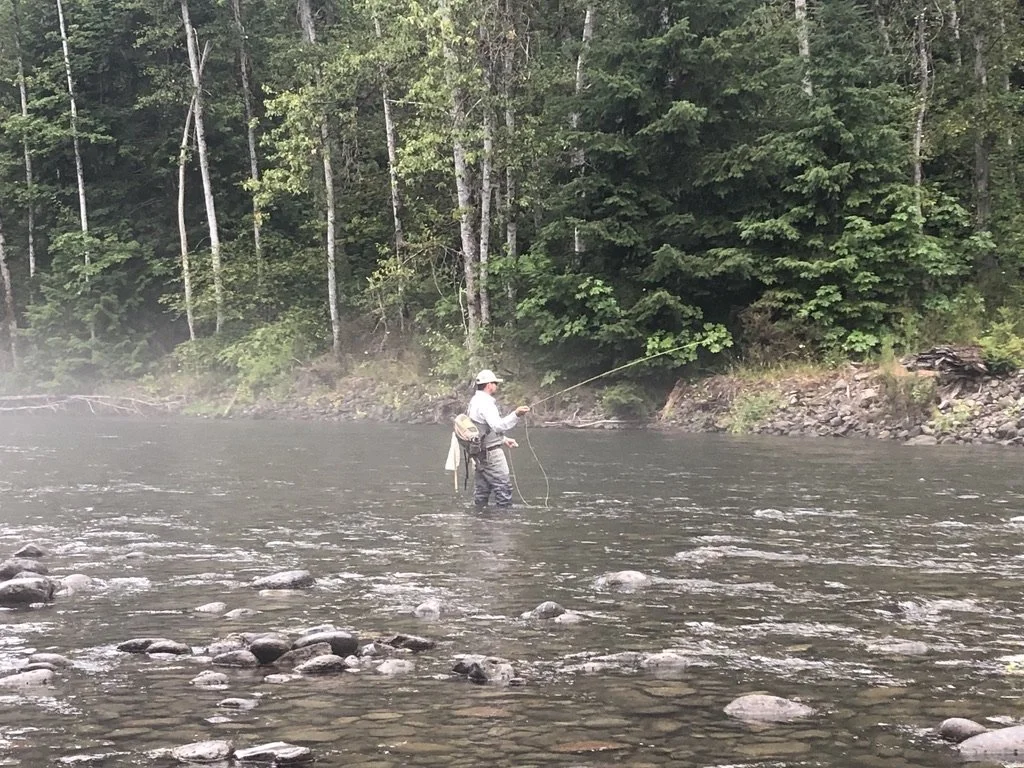Westfir’s Gem or: Not One Acre
Out in Westfir, just off U.S. Highway 58, at the southern end of the Aufderheide highway lives a river with a tongue twister of a name. The North Fork Middle Fork of the Willamette River or, the North Fork Willamette or, the North Middle Fork, or just the North Fork, is one of the Southern Willamette Valley’s treasures. Designated Wild and Scenic in 1988, the North Middle Fork has its headwaters at Waldo Lake. It boasts a 2,400 ft elevation drop in its first three miles, has over 34 waterfalls, is home to the “Miracle Mile” of whitewater, and has Oregon’s longest covered bridge—the 180 foot Office Bridge—that is the only covered bridge west of the Mississippi with a separate pedestrian walkway spanning its lower reaches. Dispersed camping sites lie scattered along its shores and the Cascade Scenic Byway tracing its route. The wilderness area has several national forest campgrounds along the way. Shared use hiking and biking trails weave throughout its basin, winding in and out of old growth forest and along the riverbanks. Fly anglers know the river because it’s one of the few barbless, fly fishing only meccas in our region with stunning wild trout. In summers of little rain when water levels drop, the river offers several swimming holes for those willing to brave its cold, gin-clear waters. To hike, ride, drive, float, wade, swim, or fish the North Middle Fork is to live something special. It’s to step out of our beeping, buzzing, ringing, streaming, trending grind and into life that reminds you why free rivers and tall trees and wild things matter. They matter because they were here first, because they’ve been here longer, and because their presence teaches us about the consequence of extraction, about loss. They do this by telling us once they’re gone, we don’t get them back and in this time of greed and cupidity that’s a lesson we all need to heed.
Back in the 1980s, we almost lived such a nightmare of loss. In a little remembered bit of wilderness history, the Springfield Utility Board proposed two dams on the North Fork. These dams would have blocked the river, sending its waters into pipes running downhill and downstream. The plan was to couple the steep gradient of the river with a gradual reduction in pipe size to gain enough head of water for electricity production. The dams would have blocked two large sections of the river while simultaneously blocking fish migration, impacting the surrounding watershed, and finally increasing the temperature of the remaining river’s flow. In a similar vein, the Emerald People’s Utility District applied to use the river’s headwaters at Waldo Lake for other power purposes. Their idea was to take water out of Waldo, send it down Black Creek, then put it through turbines into a reservoir during peak power season. And, when power demand diminished, the water would be pumped from the reservoir back up to Waldo. This would have not only raised and lowered daily water levels in a lake with the second-purest water in the world, but would’ve also significantly impacted the North Fork’s flows, watershed, wildlife, and forests. The consequence of the two projects would have been the loss of old growth forests to logging, redirected and diminished flows for a pristine river, the denudation of a total ecosystem, and the ruination of one of the planet’s purest lakes. All of this for a little bit of power.
Two local fishermen, Bob Bumstead and Glen Love, who had been fishing the North Fork for the better part of fifteen years, caught wind of the plans and were horrified. Love was an English professor at the University of Oregon, an early leader of the Association of the Study of Literature and the Environment, and author of Practical Ecocriticism, one of the Urtexts of eco-critical theory. Bumstead is a retired teacher, retired professor of education, and local fly fishing guru well known for his volunteerism and active involvement with conservation and watershed issues. Rather than rage idly, the two took the threat as a call to action, securing the help of other members of their fly fishing club, The McKenzie Fly Fishers, to fight on behalf of the wilderness. Together, Bumstead and Love worked with Jim Williams, a fellow club member, and Wendell Wilke of Oregon Natural Resources Council to oppose the plans. According to Bumstead, it was Wilke who suggested the group try to get the North Fork and Waldo Lake declared State Scenic Waterways by the Oregon legislature. Such a designation would not only stop the projects before they got started, but it would also pave the way for the Federal Government to declare the North Fork as a Federal Scenic River, a status mandating more ecologically friendly management while providing even more significant protections from so-called development.
Like many successful grassroots movements, this scrappy group of resistors won the David-and-Goliath fight with the right combination of outreach, perseverance, personal connections, and politics. Bumstead created and toured a slideshow about the beauty, natural, and cultural significance of the river and Waldo Lake. At the Oakridge presentation, Mason Williams, a Saturday Night Live writer, former Smothers Brothers musical director, and musician best known for his chart-topping “Classical Gas,” was so moved he volunteered a concert at the Hult Center to raise funds to fight the good fight. Jim Williams volunteered to produce the concert, “Time and Rivers Flowing,” which sold out for two nights and generated significant funds to counteract the dark empire of special interests and political lobbying. Riding the wave of public support at a local and national level, Love marshaled legislative and academic support leading to a bill for the State Scenic Byway establishment.
The final challenge was the committee vote where Dave Copeland, another McKenzie Fly Fisher, leveraged his childhood friendship with the Chair of the State Senate committee in hopes of a favorable vote. Copeland convinced his friend to vote yes on the proposal leading to both houses of the legislature passing the bill with almost unanimous support. In 1988, following Oregon’s example, the federal government declared the North Fork Wild and Scenic. The river was saved.
Following its federal listing, the North Fork Middle Fork of the Willamette has remained one of Westfir’s gems. The wilderness area is rife with opportunities for outdoor lovers of all sorts. The Middle Fork Ranger Station carries one of the best maps for the whole area and is essential for anyone heading out into the region. As a kind of primer for its offerings, here’s just a fraction of what you’ll find. Starting at the Covered Bridge Park, day hikers and mountain bikers can pick up the North Fork trail and walk along the river while being carried back into copses of towering conifers and quiet glens. Gravel grinders and road cyclists can simply pedal up the Aufderheide highway (U.S. Hwy 19) either completing the asphalt loop to Cougar Reservoir or working the gravel game by taking any number of forest roads that peel off the main drag. Those seeking further adventure would do well to keep the drive going on Highway 19 where trails like Alpine, Buffalo Rock, Fisher Creek, or Winchester Ridge await. Of course, there’s the old growth spots, too, such as Government Grove and Box Canyon. For those four wheel drive enthusiasts reading, I’d be remiss if I failed to mention Huckleberry Flats OHV Park. Be sure to check on fire season restrictions at the ranger station before heading out. Aside from trails and gravel and OHV parks, there’s campsites and dispersed camping all along the route. Most of these are first come, first served. However, there are a few official sites and some can be reserved, including a cabin and a horse camp. Finally, there’s the river itself: a pristine, preserved, protected ribbon tracing through all this Sasquatch country, reminding anyone who takes the time to visit about the true value of public lands.
My first trip to the North Fork happened over a decade ago and I’ve been a regular visitor ever since. I went to the river with my wife and late dog, Roscoe. The three of us were looking for our trinity of day trips: hiking, fishing, and rockhounding. We’d heard from a friend that the North Fork fit the bill and headed out. My memory of that trip has less to do with narrative and more to do with a catalogue of impressions: the rumble of the covered bridge as we drove through it; the summer smell of Douglas fir and cedar as the day warmed; cool fern glens and a sudden meadow of wildflowers we found along the ten miles of our hike; steep river banks lined with basalt and deep time; a river so clear ten feet looked as shallow as two; the rush and tumble of rapids with neither redirection nor dams ruining their course; gravel bars where agates glowed in the morning light and wary trout spooked at my clumsy casts; a sense of something old and alive and good. Indeed, that first trip to the North Fork did more than fill a day for two humans and a dog looking for adventure; it began a relationship that hasn’t waned.
Over the years, I’ve been back to the North Middle Fork more than any other river in our region. As a fly fisherman, it’s where I am always a dedicated dry fly guy. It’s where I cut my teeth on finicky, selective wild trout. For those interested in trying their luck, you can’t go wrong with tan and brown caddis during summer evenings, a #12 Adams in the early morning light, and BWOs when the hatches are coming off in the dappled light of the far bank. In July and August don’t overlook the humble ant. There’s a distinct advantage to exoskeletons, meaning, ants fall from the tops of trees down to the forest floor. Sometimes they miss, falling into the river where they don’t last long. When all else fails, casting an ant underneath an overhang or along any timber in the river is more likely than not to get a rise. Come September in the dog days, try beetles in fast water but don’t shy away from something in orange or yellow. While a standard 9-foot 5-weight rod will get the job done, I find the North Fork to be 3-weight country. The afternoon winds aren’t bad while the shorter rod helps in tough wading and casting. Granted, the fish here won’t set any state records.
The river’s cold, and fast, and spotty. On a good day you stand a chance at roping in a few in the twelve inch range. Anything above that is a genuine lunker. That said, size doesn’t always matter. These fish are strong, explosive, and uncorrupted. The river’s clear water with challenging conditions will either make or break you as a caster. It’s the river that taught me how to pay attention, how to not blow a hole by tromping into the run while trying to beat the water into submission before a first cast. Don’t worry, though. If, like me, you get humbled from time to time, Westfir’s Mountain Market has cookies and beer—the best salve on days when the river burns you.
If I’m honest, although I’ve fished the North Fork for some time now, it’s also the place I’ve not fished the most as well. It’s where I find myself just sitting, listening, watching. Sure, there are casts and fish and flies and sometimes a fair bit of cussing over bad casts and missed fish and lost flies. But I’m almost certain the total of those minutes remains less than the time I’ve put the rod down, traced fingertip patterns in the river, marveled at the wisdom of its trees, foraged, simply taken the time to be with all that life and peace. On my last trip, I planned to fish a few spots and ended up fishing one and that one not for very long. Instead, I hiked, found a rock bed, watched water ouzels forage and swim and play. I lingered. What was supposed to be a morning trip went well into the evening. On a whim, I drove the whole Aufderheide loop, stopping at Box Canyon, Government Grove. I took a spur road up a creek, saw a bear, grew enamored with a familiar place all over again. I made it all the way to Terwilliger Hot Springs, turned around and took the road back from the opposite direction for no other reason than to see it all, again, in late summer twilight. It was a good day. There are few bad days in the North Fork wilderness which, in these times, is saying something.
When the day was over and I coasted back into that beeping, buzzing, ringing, streaming, trending life waiting for me once in cell range, I was treated to a bevy of texts and emails and voice messages. Every one of them focused on the potential theft of public lands through sale hidden in the “Big Bullsh*t Bill” working through Congress. The shift in tone and mood hit hard. After all, I had just spent the whole day with a river and a forest saved from such nightmares. Yet, here it was, history repeating or, if not repeating, then at least rhyming. I asked myself how long patterns like this can keep going? How long will the places we love come under threat from those interested in taking, extracting, ruining, denuding, all in the name of alleged progress? The answer, whether we like it or not, is we keep fighting that fight as long as there’s trees growing and rivers running. We keep fighting it because those of us taking up the charge know once they’re gone, we don’t get them back, and that’s a loss that shouldn’t rhyme. So, in the face of my anger and despair, I took a lesson from those who came first, as did a lot of other people, too. We called and emailed and posted and changed a narrative. At the time of this writing, the sale has been removed even if the stench of the idea remains. What does that mean? It means there will be more—more attempts, more tries at taking, more want. And, while I don’t have much of an answer for that greed, I do know two things for sure. First, if we want to keep these places, if we want them there long after we’re gone, then we need to be there with them as much as we can. So, go take a hike, go for a swim, cast a line, sit with the river and the trees and know they were here first and let them teach you the second thing. It’s a simple lesson, really. It goes something like this: Not one acre.
Will Conable is a writer, the President of the McKenzie Guides Foundation, and the owner of Willamette Valley Fishing Guides (@willamettevalleyfishing on socials). When he’s not out guiding or fly fishing, he can be found at Home Waters Fly Shop in Eugene, Oregon, slinging flies and helping keep our community fishing. Stop by the shop, pick up some flies, and say hi to Will and the rest of the Home Waters crew sometime!
Read more stories from the mountains




